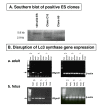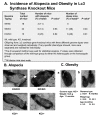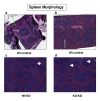Multiple phenotypic changes in mice after knockout of the B3gnt5 gene, encoding Lc3 synthase--a key enzyme in lacto-neolacto ganglioside synthesis
- PMID: 21087515
- PMCID: PMC2998480
- DOI: 10.1186/1471-213X-10-114
Multiple phenotypic changes in mice after knockout of the B3gnt5 gene, encoding Lc3 synthase--a key enzyme in lacto-neolacto ganglioside synthesis
Abstract
Background: Ganglioside biosynthesis occurs through a multi-enzymatic pathway which at the lactosylceramide step is branched into several biosynthetic series. Lc3 synthase utilizes a variety of galactose-terminated glycolipids as acceptors by establishing a glycosidic bond in the beta-1,3-linkage to GlcNaAc to extend the lacto- and neolacto-series gangliosides. In order to examine the lacto-series ganglioside functions in mice, we used gene knockout technology to generate Lc3 synthase gene B3gnt5-deficient mice by two different strategies and compared the phenotypes of the two null mouse groups with each other and with their wild-type counterparts.
Results: B3gnt5 gene knockout mutant mice appeared normal in the embryonic stage and, if they survived delivery, remained normal during early life. However, about 9% developed early-stage growth retardation, 11% died postnatally in less than 2 months, and adults tended to die in 5-15 months, demonstrating splenomegaly and notably enlarged lymph nodes. Without lacto-neolacto series gangliosides, both homozygous and heterozygous mice gradually displayed fur loss or obesity, and breeding mice demonstrated reproductive defects. Furthermore, B3gnt5 gene knockout disrupted the functional integrity of B cells, as manifested by a decrease in B-cell numbers in the spleen, germinal center disappearance, and less efficiency to proliferate in hybridoma fusion.
Conclusions: These novel results demonstrate unequivocally that lacto-neolacto series gangliosides are essential to multiple physiological functions, especially the control of reproductive output, and spleen B-cell abnormality. We also report the generation of anti-IgG response against the lacto-series gangliosides 3'-isoLM1 and 3',6'-isoLD1.
Figures









Similar articles
-
Lack of lacto/neolacto-glycolipids enhances the formation of glycolipid-enriched microdomains, facilitating B cell activation.Proc Natl Acad Sci U S A. 2010 Jun 29;107(26):11900-5. doi: 10.1073/pnas.0914298107. Epub 2010 Jun 14. Proc Natl Acad Sci U S A. 2010. PMID: 20547865 Free PMC article.
-
Cloning of a mouse beta 1,3 N-acetylglucosaminyltransferase GlcNAc(beta 1,3)Gal(beta 1,4)Glc-ceramide synthase gene encoding the key regulator of lacto-series glycolipid biosynthesis.J Biol Chem. 2001 Aug 10;276(32):30261-9. doi: 10.1074/jbc.M102979200. Epub 2001 May 30. J Biol Chem. 2001. PMID: 11384981
-
GMab-1, a high-affinity anti-3'-isoLM1/3',6'-isoLD1 IgG monoclonal antibody, raised in lacto-series ganglioside-defective knockout mice.Biochem Biophys Res Commun. 2010 Jan 1;391(1):750-5. doi: 10.1016/j.bbrc.2009.11.132. Epub 2009 Nov 26. Biochem Biophys Res Commun. 2010. PMID: 19944071 Free PMC article.
-
Gangliosides associated with primary brain tumors and their expression in cell lines established from these tumors.Prog Brain Res. 1994;101:225-40. doi: 10.1016/s0079-6123(08)61952-4. Prog Brain Res. 1994. PMID: 8029453 Review.
-
The chemical constitution of gangliosides of the vertebrate nervous system.Behav Brain Res. 1995 Jan 23;66(1-2):85-97. doi: 10.1016/0166-4328(94)00129-4. Behav Brain Res. 1995. PMID: 7755905 Review.
Cited by
-
Ganglioside biochemistry.ISRN Biochem. 2012 Dec 19;2012:506160. doi: 10.5402/2012/506160. eCollection 2012. ISRN Biochem. 2012. PMID: 25969757 Free PMC article. Review.
-
Synthesis of a novel photoactivatable glucosylceramide cross-linker.J Lipid Res. 2016 Sep;57(9):1728-36. doi: 10.1194/jlr.D069609. Epub 2016 Jul 13. J Lipid Res. 2016. PMID: 27412675 Free PMC article.
-
Tumor-Expressed SPPL3 Supports Innate Antitumor Immune Responses.Eur J Immunol. 2025 Feb;55(2):e202451129. doi: 10.1002/eji.202451129. Epub 2024 Dec 10. Eur J Immunol. 2025. PMID: 39655358 Free PMC article.
-
Structural and Functional Analysis of Murine Polyomavirus Capsid Proteins Establish the Determinants of Ligand Recognition and Pathogenicity.PLoS Pathog. 2015 Oct 16;11(10):e1005104. doi: 10.1371/journal.ppat.1005104. eCollection 2015 Oct. PLoS Pathog. 2015. PMID: 26474293 Free PMC article.
-
Gene Signature of Human Oral Mucosa Fibroblasts: Comparison with Dermal Fibroblasts and Induced Pluripotent Stem Cells.Biomed Res Int. 2015;2015:121575. doi: 10.1155/2015/121575. Epub 2015 Aug 3. Biomed Res Int. 2015. PMID: 26339586 Free PMC article.
References
-
- Pan B, Fromholt SE, Hess EJ, Crawford TO, Griffin JW, Sheikh KA, Schnaar RL. Myelin-associated glycoprotein and complementary axonal ligands, gangliosides, mediate axon stability in the CNS and PNS: neuropathology and behavioral deficits in single- and double-null mice. Exp Neurol. 2005;195:208–217. doi: 10.1016/j.expneurol.2005.04.017. - DOI - PMC - PubMed
-
- Vyas AA, Patel HV, Fromholt SE, Heffer-Lauc M, Vyas KA, Dang J, Schachner M, Schnaar RL. Gangliosides are functional nerve cell ligands for myelin-associated glycoprotein (MAG), an inhibitor of nerve regeneration. Proc Natl Acad Sci USA. 2002;99:8412–8417. doi: 10.1073/pnas.072211699. - DOI - PMC - PubMed
Publication types
MeSH terms
Substances
Grants and funding
LinkOut - more resources
Full Text Sources
Molecular Biology Databases

